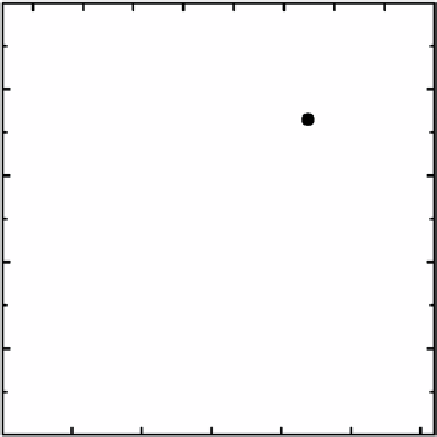Geology Reference
In-Depth Information
Petrographically the most unusual feature is the wide
range of magnesium numbers (
Mg'
= mole% MgO/
(MgO + FeO) in the mafic minerals associated with the
feldspathic lithologies, 36-87 [
Goodrich et al
., 1984;
Gross
and Treiman
, 2010;
Gross et al
., 2014].
Early compositional studies [
Boynton and Hill
, 1983;
Kallemeyn and Warren
, 1983;
Korotev et al
., 1983;
Laul
et al
., 1983;
Palme et al
., 1983] noted that ALH A81005
had low concentrations of elements associated with
KREEP compared to polymict materials (regoliths
and breccias) from the
Apollo
16 site (Figure 6.3), the
only
Apollo
mission to have landed in the feldspathic
highlands at a point distant from basalt-filled impact
basins (Figure 6.1). As more feldspathic lunar meteor-
ites were found and data from the Lunar Prospector
mission [
Lawrence et al
., 2000] were assimilated, it
became apparent that the meteorites are, in fact, typ-
ical of the feldspathic highlands, and it is the
Apollo
16
site that is anomalous as a result of its proximity to
the Procellarum KREEP Terrane (Figure 6.2) and the
presence of high-Th Imbrium ejecta at the site [
Korotev
et al
., 2003a] (Figure 6.4). The meteorite remains
among the most magnesian (high
Mg'
) of the feld-
spathic lunar meteorites (Figure 6.7) [
Korotev
, 2012;
Gross et al
., 2014].
Normative plagioclase (%)
20
30
40
50
60
70
80
90
100
80
G
ANSMET
lunar meteorite
stones
A
Feldspathic
70
P
¥
Q
¢
¢
I M
60
£
$
U
50
Intermediate
e
E
T
40
Basaltic
B
1
30
5
10
15
20
25
30
35
Al
2
O
3
(%)
Figure 6.7.
Mg'
varies considerably among ANSMET feld-
spathic lunar meteorites. Each point represents a named stone;
see Table 6.1 for symbol key. For reference, the mean composi-
tion of typical mature regolith from
Apollo
16 is represented by
the filled circle [
Korotev
, 1997]. The normative plagioclase axis
assumes an An
96
composition for the plagioclase.
6.5.2. Elephant Moraine 87521 and 96008
EET 87521 was originally classified as a brecciated
eucrite but was later recognized to be a lunar meteorite
composed mainly of brecciated VLT (very low Ti, <1%
TiO
2
) mare basalt [
Delaney
, 1989;
Warren and Kallemeyn
,
1989]. A paired stone, EET 96008, was found nine years
later. Prior to EET 87/96, VLT basalt was known only from
small fragments in the
Apollo
17 and
Luna
24 regoliths
[
Vaniman and Papike
, 1977;
Ma et al
., 1978]. The VLT
basalt of EET 87/96 has a crystallization age of about
3.5 Ga (Figure 6.8; Plate 65).
Early works classified the meteorite as a fragmental
breccia, but the presence of rare glass spherules and
agglutinates [
Mikouchi
, 1999] confirm that it is a highly
immature regolith breccia. The meteorite is characterized
by coarse pyroxenes with exsolution lamellae and inter-
growths of silica, fayalite, and hedenbergite; both features
are rare in
Apollo
basalts [
Anand et al
., 2003;
Warren and
Kallemeyn
, 1989;
Takeda et al
., 1992]. The meteorite is also
unusual in that there are no breccias in the
Apollo
collection
that, like EET 87/96, consist mainly of mineral grains from
coarse-grained volcanic rocks and have such little glass
[
Korotev et al.
, 2003b].
Although petrographic evidence for feldspathic
clasts is rare [
Warren and Kallemeyn
, 1989;
Anand
et al
., 2003;
Takeda et al
., 1992;
Warren and Ulff-
Møller
, 1999], the FeO concentration of the meteorite
6.5. ROSTER OF ANSMET LUNAR METEORITES
Below, we discuss the ANSMET lunar meteorites in
order of discovery. Few data are available for the most
recently discovered meteorites. In contrast, we are aware
of 38 peer-reviewed papers reporting data for Allan Hills
81005.
6.5.1. Allan Hills A81005
ALH A81005, the first meteorite recognized to be from
the Moon [
Marvin
, 1983;
Cassidy
, 2003], was collected
nine years after the last
Apollo
mission (Plate 64). The
rock is a regolith breccia from the lunar highlands. Like
most feldspathic regolith breccias, lithic clasts are mainly
other types of breccias: granulitic breccias, impact-melt
breccias, and monomict breccias all derived from anor-
thosites, noritic anorthosites, troctolitic anorthosites, and
their more mafic variants. The meteorite also contains
rare clasts of mare basalts and impact-glass spherules all
set in a dark matrix of minerals clasts and impact-derived
vesicular glass [
Korotev et al
., 1983;
Kurat and Brandstätter
,
1983;
Marvin
, 1983;
Ryder and Ostertag
, 1983;
Simon
et al
., 1983;
Treiman and Drake
, 1983;
Warren et al
., 1983;
Goodrich et al
., 1984;
Gross and Treiman
, 2010].

